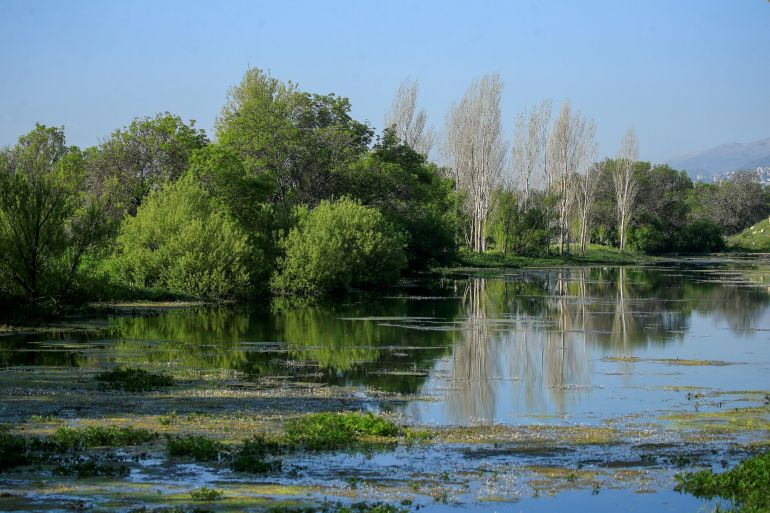Restoring wetlands can help combat climate change
Swamps are a major carbon store. Their regeneration can help sequester vast amounts of carbon dioxide.

Drain the swamp! It is an old cry. Swamps are badlands where malaria breeds, mists settle, tracks disappear, criminals lurk and bad things happen. Bog or mire, morass or swamp, even their names give wetlands a bad reputation. Unlike scary jungles, which have been successfully rebranded as magical and biodiverse rainforests, wetlands are for many people still stuck in a quagmire of disregard.
That includes many policymakers, and even some environmentalists. Ahead of the climate conference in Glasgow, Scotland, many delegates have championed the cause of conserving and restoring forests as a way to soak up carbon dioxide and fight climate change. Recently, $1bn was pledged to the cause by governments and private companies. This is indeed absolutely necessary. But where is the same commitment – and the same finance – for wetlands?
Keep reading
list of 4 itemsAfter the Hurricane
World’s coral reefs face global bleaching crisis
Why is Germany maintaining economic ties with China?
If the gap is not filled, a great chance will have been missed. Because if you thought most of the carbon stored in natural ecosystems was in forests, you would be wrong. It is in wetlands. If you thought the potential for harnessing nature to fight climate change was all about the fate of forests, you would also be wrong. The fate of wetlands is at least as important.
So delegates in Glasgow will be right to kickstart a global programme to restore forests. But achieving their goal of limiting warming to 1.5 degrees C will require complementary action to protect and restore the world’s overlooked and undervalued wetlands.
Carbon and water stores
Wetlands – which include river floodplains and deltas, lakes and salt marshes, mangroves and peatlands – are disappearing three times faster than natural forests; drained or dyked, filled in or paved over, converted to rice paddies or fish ponds.
This loss of accumulated waterlogged organic matter is releasing huge volumes of greenhouse gases into the air. A typical hectare of coastal mangrove swamp holds four times more carbon than tropical forests. Peatlands, often thousands of years in the making, store twice more carbon than all vegetation types on the planet’s surface put together. Just one, the Cuvette Centrale in the Congo basin, contains more carbon than all the trees in the basin’s rainforests.
But draining them oxidizes the carbon and turns it into carbon dioxide. Around five percent of annual global greenhouse gas emissions come from draining peatlands. According to researchers of nature-based solutions to climate change, protecting the world’s remaining peatlands could shave a third of a degree Celsius off global warming later this century.
But wetlands are not just carbon stores. They are also water stores – vital for protecting us from extreme weather events already happening. By regulating water flows, they keep rivers full in droughts and reduce surges downstream when it is wet. Drain them, or cut them off from their rivers, and the result is empty river beds and raging floods.
The deluges of water that ripped through parts of western Germany earlier this year may have been triggered by climate change, but they were certainly made worse because many of the wetlands that once captured and held back heavy rains have been drained. Rainfall washed into rivers much faster than in the past, bursting banks and flooding hundreds of towns downstream. Many of the 200-plus who died would have been saved if wetlands had not been lost.
Wetlands perform many other roles. They nurture fisheries and freshwater biodiversity; they water crops and seep downwards to maintain underground water reserves. They protect our shores from high tides, storms and even tsunamis.
They also act as firebreaks and help prevent the spread of wildfires. Last year droughts and fires devastated drained wetlands in Bolivia, Paraguay and the Pantanal in Brazil. Much of the Amazon is wetland as well as rainforest, and as the wet places dry out, forest fires are worsening there too.
Wetland restoration
The science on the importance of wetlands is in. And the technical know-how of restoration is well demonstrated. Affordable and scalable nature-based solutions are ready to be deployed, with local communities and Indigenous people at the heart of the action.
After peat fires a decade ago blanketed Moscow in thick smoke that killed thousands, Wetlands International and partners helped remove dykes to rewet some 400 square kilometres of former bogs in the region around the Russian capital. This has both prevented new disasters and eliminated carbon dioxide emissions at less than a dollar per tonne.
We are also working with fishing communities in northern Java to encourage natural regeneration of lost mangroves; restoring swamp forests in the heart of Borneo; helping rewet eroding yak pastures in upland China; and questioning dams that would drain the Inner Niger Delta, a vital oasis on the edge of the Sahara that is shared by fishers, farmers and herders.
Conserving and restoring wetlands must be an integral part of climate action. Nature-based solutions are the smartest investments to draw down carbon from the atmosphere and reach net zero, while providing climate resilience and adaptation. What we need now is climate finance to redouble the protection and restoration of the world’s largest natural stores of carbon.
COP26 in Glasgow, to be held just down the road from peat bogs in the Scottish Flow Country which store vast amounts of carbon, would be the ideal place to start.
The views expressed in this article are the author’s own and do not necessarily reflect Al Jazeera’s editorial stance.
